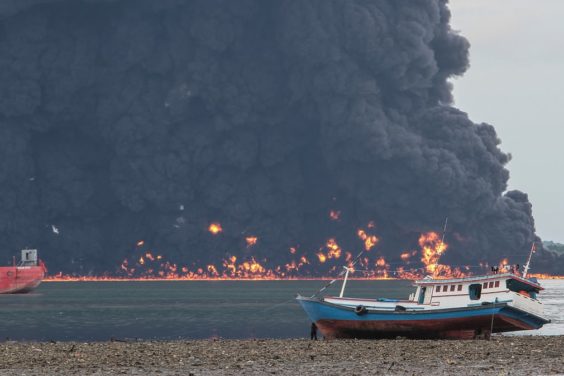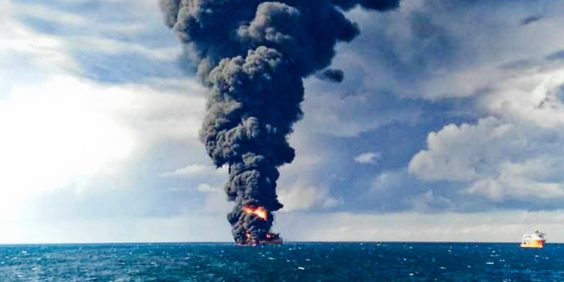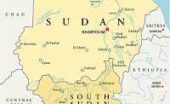Re Ian Bremmer 'Could third-party candidates upend the 2024 US election?' 3 April The current political movement in the USA…
Oil & gas spills and leaks
Written by Diana Thebaud Nicholson // December 11, 2022 // Environment & Energy, Oil & gas // Comments Off on Oil & gas spills and leaks
Oil spills and leaks
Wikipedia: List of oil spills
Heather Cox Richardson: December 11, 2022
The Keystone Pipeline ruptured Wednesday night near a creek in northern Kansas, spilling what its operator, TC Energy, says is about 14,000 barrels of oil. This is equivalent to about 588,000 gallons (an Olympic swimming pool holds about 666,000 gallons). TC Energy says the leak is now contained.
This is the largest land-based crude pipeline spill in the U.S. in nine years. Although the Keystone Pipeline has leaked 22 times before this, this week’s spill is bigger than all the others put together. A spill in July 2010 was more expensive— costing more than $1 billion— because it affected the Kalamazoo River in Michigan.
The leak recalls arguments over the extension of the Keystone Pipeline, known as the XL Pipeline, that right-wing Republicans made a symbol of what they considered an antigrowth attack on U.S. energy production by Democrats.
A reminder: the Keystone Pipeline runs from oil sand fields in Alberta, Canada, into the United States and to Cushing, Oklahoma. It is fully operational. The XL Pipeline—the one that folks often confuse with the actual Keystone Pipeline—consists of two new additions to the original pipeline. As planned, they would have added up to 1700 new miles. One addition was designed to connect Cushing to oil refineries in Texas, on the Gulf Coast. That section was built and started operating in January 2014. …
Now the U.S. has invested heavily in switching the United States to renewable energy with the Inflation Reduction Act, and a major oil spill resurrects concerns about the transportation of oil.
It is poetic timing. On Friday, as part of their yearlong investigation of the fossil fuel industry, the House Committee on Oversight and Reform released documents from executives at major oil companies revealing that they recognize that their products are creating a climate emergency but that they have no real plans for changing course.
9 December
Keystone pipeline leaks 14,000 barrels of oil into creek in biggest spill yet
The leak occurred in Washington county, Kansas, with the affected segment being ‘isolated’ and the drip contained
29 September
Sweden reports fourth Nord Stream pipeline leak
Reports say largest rupture is causing circle of bubbles at Baltic Sea surface of about 900 metres in diameter
(The Guardian) Swedish authorities have reported a fourth leak on one of the two Nord Stream pipelines that EU leaders believe was the target of sabotage at the start of the week.
Natural gas has been pouring into the Baltic Sea from both pipelines since Monday. They were built to carry gas from Russia to Germany, but Nord Stream 2 has never been activated and Nord Stream 1 has been out of operation since the start of September. Both, however, were loaded with gas when the ruptures occurred.
Seismologists in Sweden and Denmark recorded underwater blasts near the island of Bornholm on Monday morning and Monday evening, suggesting a deliberate act of sabotage. A seismologist quoted by Svenska Dagbladet did not rule out the possibility of a third blast.
Germany’s security agencies believe the damage has made the offshore pipelines “unusable forever”, Tagesspiegel newspaper reported government officials as saying. A source cited by Der Spiegel said German security circles believed the leaks were caused by high-powered explosives equivalent to 500kg of TNT.
Nord Stream gas leaks may be biggest ever, with warning of ‘large climate risk’
‘Colossal amount’ of leaked methane, twice initial estimates, is equivalent to third of Denmark’s annual CO2 emissions or 1.3m cars.
Nord Stream spill could be biggest methane leak ever but not catastrophic
(WaPo) The two explosions in the Nord Stream 1 and 2 pipelines in the Baltic Sea resulted in what could amount to the largest-ever single release of methane gas into the atmosphere, but it may not be enough to have a major effect on climate change, experts say.
While sudden influxes of methane from underwater pipelines are unusual and scientists have little precedent to fall back on, the consensus is that with so much methane spewing into the atmosphere from all around the globe, the several hundred thousand tons from the pipelines will not make a dramatic difference.
2020
3 October
‘Major’ Oil Spill Off California Coast Threatens Wetlands and Wildlife
A pipeline failure sent at least 126,000 gallons of oil into the Pacific off the coast of Orange County, creating a 13-square-mile slick. Dead fish and birds washed ashore in some areas
14 June
Trans Mountain oil spill released roughly 150,000 litres of oil, company says
The spill was contained Saturday, and a cleanup effort has been ongoing ever since.
9 June
Russian Arctic oil spill pollutes big lake near Norilsk
Diesel oil from a huge spill in Russia’s Arctic north has polluted a large freshwater lake and there is a risk it could spread into the Arctic Ocean, a senior Russian official says.
(BBC) Emergency teams are trying to contain the oil, which has now travelled about 20km (12 miles) north of Norilsk from a collapsed fuel tank.
It is the worst accident of its kind in modern times in Russia’s Arctic region, environmentalists and officials say.
The oil started leaking on 29 May.
So far about 21,000 tonnes have contaminated the Ambarnaya river and surrounding subsoil.
Investigators believe the storage tank near Norilsk sank because of melting permafrost, which weakened its supports. The Arctic has had weeks of unusually warm weather, probably a symptom of global warming.
A 2017 report to the Arctic Council, an international forum which includes Russia, warned that because of global warming and melting ice, foundations in permafrost regions could no longer support the loads they did as recently as the 1980s.
A recent report by Bloomberg news agency points out that Russia’s newer oil infrastructure takes account of the changing climate: storage tanks on the Yamal Peninsula, for instance, are mounted on piles.
13 February
Deepwater Horizon disaster had much worse impact than believed, study finds
Effects of 2010 BP oil spill were 30% larger than calculated
Satellite images unable to detect full extent of pollution in Gulf
(The Guardian) …a new study published on Thursday in the Science Advances journal says satellite surveillance at the time was unable to detect large areas of oil contamination. The study’s authors found that the effects of the spill were 30% larger, reaching the Texas shore, the Florida Keys, the coast of Tampa and parts of the east coast of Florida. “The satellite footprint does not necessarily capture the entire oil spill extent,” the study found.
2019
23 December
‘It’s Impossible to Clean It All Up’: 600-Gallon Oil Spill in Galapagos Kills Wildlife and Disrupts Food Chains
(Newsweek) A clean-up mission is in full swing after a 600-gallon oil spill left parts of the Galapagos Islands covered in diesel fuel on Sunday.
The spill is reportedly the result of an error at a port on San Cristobal Island. An accident saw a crane collapse as it was loading a barge with a container carrying an electric generator. The falling container rocked the vessel, causing it to submerge along with the crane and electrical generator. One person was injured in the incident.
Authorities have declared a state of emergency in an effort to contain the spill. According to Ecuador officials, the situation is “under control” and “a series of actions have been deployed to mitigate the possible effects,” the AFP reports.
The Emergency Operations Committee (COE) is working to limit the risk to the environment. Meanwhile, members of the official nature reserve authority and Ecuadorian Navy are working with the Galapagos National Park (GNP) to limit the damage to the natural environment.
18 November
More land affected by Keystone pipeline leak than originally thought
(AP via PBS) A crude oil spill from the Keystone pipeline in eastern North Dakota has turned out to have affected almost 10 times the amount of land as first reported, a state regulator said Monday.
North Dakota environmental scientist Bill Suess said the leak reported on Oct. 29 is now estimated by state regulators to have affected about 209,100 square feet (19,426 square meters) of land near Edinburg
Crude began flowing through the $5.2 billion pipeline in 2011. It’s designed to carry crude oil across Saskatchewan and Manitoba, and through North Dakota, South Dakota, Nebraska, Kansas and Missouri on the way to refineries in Patoka, Illinois and Cushing, Oklahoma. It can handle about 23 million gallons (87 million liters) daily.
It is part of a system that also is to include the proposed $8 billion Keystone XL pipeline designed to transport the oil from western Canada to terminals on the Gulf Coast.
Nearly three months after Brazil oil spill, origins remain uncertain
Oil was first sighted on Brazil’s northeastern coast on August 30, with more than 4,000 tons washing up since. Authorities claim the oil didn’t come from Brazil, but rather had come from a tanker loaded with crude from Venezuela — a failed state.
The trending theory is that the dumping was done by a “dark ship” with its location transponders intentionally turned off so as to dodge U.S. sanctions against the transport of Venezuelan oil. While “bilge dumping” could be the cause, analysts say the practice isn’t likely to have resulted in Brazil’s mass spill.
The government initially identified one tanker as the likely perpetrator and then expanded to five possible culprits. But a new analysis of satellite data by Federal University of Alagoas researchers may have pinpointed the responsible tanker; those findings are to be presented to the Brazilian Senate on November 21.
The Bolsonaro government has been faulted for its disaster response. It seemed unaware of Brazil’s 2013 National Contingency Plan for dealing with spills, and didn’t enact the plan until October 11. Also, the executive committee charged with implementing the plan was disbanded by the administration early in 2019.
29 July
Chile oil spill: 40,000 litres of diesel spilled into sea off Patagonia
Chile’s navy confirmed it was working to mitigate damage caused by the spill at Guarello island
6 April
Oil Spill Now Larger Than Paris Ravages Indonesian Island, 5 Dead
By Basten Gokkon
(Ecowatch) An oil spill in Borneo that began over the past weekend has now spread across an area greater than the city of Paris and is heading out to the open ocean, the Indonesian government said.
The spill, first reported on March 31, stems from a pipeline operated by state-owned oil firm Pertamina in the city of Balikpapan, in East Kalimantan province. A report released April 4 by the Ministry of Environment and Forestry said the slick was spreading out from Balikpapan Bay and into the Strait of Makassar, covering some 130 square kilometers (50 square miles).
Pertamina, which for days had denied responsibility for the disaster, finally admitted on April 4 that one of its pipes used for transporting crude oil was the source of the slick.
Some 84 acres of mangrove forests are covered in oil, the environment ministry report said. The slick is also believed to have led to the death of an endangered Irrawaddy dolphin (orcaella brevirostris), a protected species under Indonesian law, which was found washed up on the coast near the site of the spill.
2 March
More than 50 missing after oil pipeline explosion in Nigeria
Spillage following blaze sparked stampede in Nembe kingdom, Bayelsa state
(The Guardian) The blast early on Friday caused massive oil spillage in the Nembe kingdom in Bayelsa state, the Nembe Chiefs Council spokesman, Chief Nengi James-Eriworio, told the Associated Press.
The Nembe trunk line is operated by the Port Harcourt-based Aiteo Group and carries crude oil to the Bonny export terminal. Aiteo has yet to comment on the explosion. It was not immediately clear if the pipeline has been shut down.
Video obtained by the AP shows a large blaze from the ruptured pipeline at night as villagers look on. “If they turn off the oil well from the station, the pressure inside the pipeline would reduce, causing the flame to burn out,” one person is heard in the background explaining.
The Niger Delta is highly polluted. Nigerian oil companies usually assert that the majority of oil spills are caused by sabotage, theft and illegal refining.
Fatal accidents caused by leaking pipelines are common. In January, an overturned oil tanker exploded in Odukpani in Cross River state while dozens of people were scooping up the leaking fuel. Police said at least 12 people were killed while some witnesses estimated up to 60 were dead
1 March
Alarm over failure to deal with Solomon Islands oil spill threat
Mining operations continue while more than 500 tonnes of fuel oil remain on board MV Solomon Trader, almost a month after it ran aground
The environmental damage from an oil spill in the Solomon Islands has been worsened by a bauxite mining company’s continued loading operations near the site where a $30m bulk carrier went aground last month. The Solomon Islands government has sought urgent help from Australia to deal with the environmental disaster because of frustrations at the slow progress in dealing with the spill. The oil is yet to reach East Rennell, the largest raised coral atoll in the world and a world heritage site. Since 2013 the site has been on a Unesco danger list because of logging and overfishing. Authorities are concerned the ship is at risk of breaking upwhile Bintan Mining Solomon Islands Limited, the Indonesian company that chartered the vessel, continues to load bauxite with other bulk carriers.
2018
21 October
 An aerial image of an oil slick in the Gulf of Mexico, taken on April 28, 2018. (Oscar Garcia-Pineda)
An aerial image of an oil slick in the Gulf of Mexico, taken on April 28, 2018. (Oscar Garcia-Pineda)
A 14-year-long oil spill in the Gulf of Mexico verges on becoming one of the worst in U.S. history
14 years after Ivan took down Taylor’s platform, the broken wells are releasing so much oil that researchers needed respirators to study the damage.
(WaPost) An oil spill that has been quietly leaking millions of barrels into the Gulf of Mexico has gone unplugged for so long that it now verges on becoming one of the worst offshore disasters in U.S. history.
Between 300 and 700 barrels of oil per day have been spewing from a site 12 miles off the Louisiana coast since 2004, when an oil-production platform owned by Taylor Energy sank in a mudslide triggered by Hurricane Ivan. Many of the wells have not been capped, and federal officials estimate that the spill could continue through this century. With no fix in sight, the Taylor offshore spill is threatening to overtake BP’s Deepwater Horizon disaster as the largest ever.
As oil continues to spoil the Gulf, the Trump administration is proposing the largest expansion of leases for the oil and gas industry, with the potential to open nearly the entire outer continental shelf to offshore drilling. That includes the Atlantic coast, where drilling hasn’t happened in more than a half century and where hurricanes hit with double the regularity of the Gulf. …
The Taylor Energy spill is largely unknown outside Louisiana because of the company’s effort to keep it secret in the hopes of protecting its reputation and proprietary information about its operations, according to a lawsuit that eventually forced the company to reveal its cleanup plan. The spill was hidden for six years before environmental watchdog groups stumbled on oil slicks while monitoring the BP Deepwater Horizon disaster a few miles north of the Taylor site in 2010.
The Interior Department is fighting an effort by Taylor Energy to walk away from the disaster. The company sued Interior in federal court, seeking the return of about $450 million left in a trust it established with the government to fund its work to recover part of the wreckage and locate wells buried under 100 feet of muck.
6 April
 Photograph: Paksi Sandang Prabowo/Kaltim Post/Greenpeace
Photograph: Paksi Sandang Prabowo/Kaltim Post/Greenpeace
Oil Spill Now Larger Than Paris Ravages Indonesian Island, 5 Dead
By Basten Gokkon
(EcoWatch) An oil spill in Borneo that began over the past weekend has now spread across an area greater than the city of Paris and is heading out to the open ocean, the Indonesian government said.
The spill, first reported on March 31, stems from a pipeline operated by state-owned oil firm Pertamina in the city of Balikpapan, in East Kalimantan province. A report released April 4 by the Ministry of Environment and Forestry said the slick was spreading out from Balikpapan Bay and into the Strait of Makassar, covering some 130 square kilometers (50 square miles).
Pertamina, which for days had denied responsibility for the disaster, finally admitted on April 4 that one of its pipes used for transporting crude oil was the source of the slick.
“Our preliminary investigation had indicated that the oil was ship fuel, but it was only until [the evening of April 3] that we got confirmation that it was from us,” Pertamina general manager Togar M.P. told reporters. “Ever since the incident was discovered, we have shut down the pipes.”
(The Guardian) Deadly oil spill devastates Borneo port city – in pictures
Meanwhile this from BP
Massive Oil Spill ‘Welcome Boost’ to Economy, Says BP
(Newsweek) Coastal towns would enjoy an economic boon from a massive oil spill in the Great Australian Bight, BP claimed in newly revealed documents from a 2016 drilling bid.
The oil giant said any cleanup operation following a huge spill would bring a “welcome boost to local economies.” The claim was uncovered via a freedom of information request by the U.K.-based Climate Home News website.
Though it has since withdrawn the controversial plan to drill for oil in the Bight, BP also told the Australian regulatory authority that a diesel spill would be considered “socially acceptable” because “there are no unresolved stakeholder concerns.”
6-14 January
Photos: Iranian tanker on fire after crashing into Chinese ship and spilling tonnes of oil into the ocean
 A large plume of smoke emanates from the Sanchi in the East China Sea on Sunday, January 14. Chinese Ministry of Transport via AP
A large plume of smoke emanates from the Sanchi in the East China Sea on Sunday, January 14. Chinese Ministry of Transport via AP
(Business Insider) A huge fire broke out on an Iranian oil tanker days after it collided with a Chinese ship in the East China Sea.
The Sanchi had been carrying $60 million worth of natural gas condensate.
Burning Iranian oil tanker sinks after January 6 accident: Chinese state TV
(Reuters) – An Iranian oil tanker has sunk after burning for more than a week following a collision on Jan. 6 in the East China Sea, Chinese state media said on Sunday, adding that a large amount of oil was burning in the surrounding waters.
The stricken tanker, called the Sanchi (IMO:9356608), which had been adrift and on fire following the accident with the freighter CF Crystal, had “suddenly ignited” around noon (0400 GMT), China Central Television (CCTV) said.
“Currently it has already sunk,” CCTV said, citing the Shanghai maritime search and rescue center. It showed video of a tower of billowing black smoke that it said reached as high as 1,000 meters, and flames on the surface of the water. The ship sank before 5 p.m. (0900 GMT), the broadcaster said.
2017
14 December
After years of toxic oil spills, indigenous Peruvians use tech to fight back
Fidel Sandi’s Achuar community has been plagued with oil contamination for decades – but he is now able to collect and gather evidence for his claim
(The Guardian) Armed with territorial knowledge, rubber boots, smartphones and drones, indigenous Amazonians in Peru are doing what state and private oil companies have long failed to do: report oil spills that have been polluting their corner of the rainforest for decades.
16 November
Keystone Pipeline leaks 210,000 gallons of oil in South Dakota
(CNN)A total of 210,000 gallons of oil leaked Thursday from the Keystone Pipeline in South Dakota, the pipeline’s operator, TransCanada, said.
Crews shut down the pipeline Thursday morning, and officials are investigating the cause of the leak, which occurred about three miles southeast of the town of Amherst, said Brian Walsh, a spokesman for the state’s Department of Environment and Natural Resources.
14 September
Floating Tar, Dead Fish: Oil Spill Threatens Greek Beaches
(NYT) The Greek authorities scrambled on Thursday to clean up fuel leaked by an oil tanker that sank near Athens, putting popular beaches off limits to swimmers and raising fears of environmental damage.
The Agia Zoni II, a 45-year-old oil tanker, sank early Sunday morning near the island of Salamis, about seven miles from the country’s main port, Piraeus. It was carrying more than 2,500 metric tons of fuel oil and marine gas oil.
Though the leak was initially thought to be contained to the area of the shipwreck, it soon expanded to the coastline area known as the Athens Riviera.
Some ecologists have called the oil spill an environmental disaster, with immediate and potential long-term effects.
The Hellenic Register of Shipping, an independent organization that oversees shipping safety, said that the tanker had not been certified as seaworthy, although its owner, Fos Petroleum, said that it had all of the proper credentials. The Greek Ministry of Shipping and Island Policy did not respond to several requests for information



